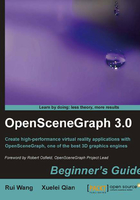
Time for action—heading
- Action 1
- Action 2
- Action 3
Instructions often need some extra explanation so that they make sense, so they are followed with:
What just happened?
This heading explains the working of tasks or instructions that you have just completed.
You will also find some other learning aids in the book, including:
Pop quiz—heading
These are questions intended to help you test your own understanding.
Have a go hero—heading
These set practical challenges and give you ideas for experimenting with what you have learned.
You will also find a number of styles of text that distinguish between different kinds of information. Here are some examples of these styles, and an explanation of their meaning.
Code words in text are shown as follows: "CMake will generate an OpenSceneGraph.sln file at the root of the build directory".
A block of code is set as follows:
#include <osg/PolygonMode> #include <osg/MatrixTransform> #include <osgDB/ReadFile> #include <osgViewer/Viewer>
Any command-line input or output is written as follows:
# osgviewer --image picture_name.bmp
New terms and important words are shown in bold. Words that you see on the screen, in menus or dialog boxes for example, appear in the text like this: "Start the installer and you will see the Choosing Language dialog, the Welcome page, and the License Agreement page".